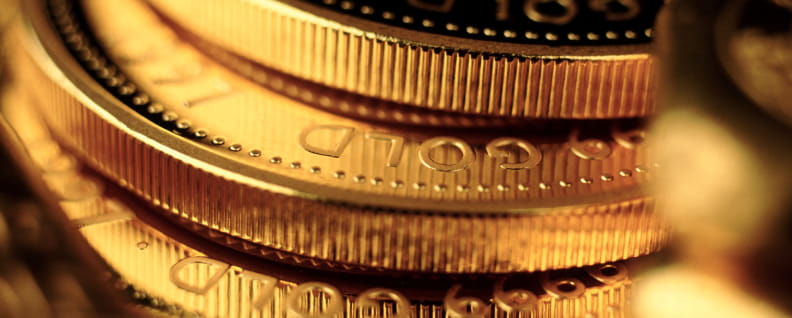
What is gold trading?
Gold trading is the practice of speculating on the price of gold markets in order to make a profit – usually via futures, options, spot prices or shares and exchange-traded funds (ETFs). Usually, physical gold bars or coins are not handled during the transaction; instead they are settled in cash.
There are a number of reasons why you might decide to trade gold, including pure speculation, wanting to buy and take ownership of the physical gold, or as a hedge against instability.
When trading gold, you don’t necessarily need to hold the traditional mantra of ‘buy low, sell high’, as you can go long and short on gold prices – taking advantage of markets that fall in price, as well as those that rise. Whichever position you take, the aim of gold trading is to predict which direction the market will move in. The further the market moves in the direction you’ve predicted, the more you’d profit and the more it moves against you, the higher your losses.
Ready to start trading gold? Open an account today.
Forex vs gold trading
Your decision about whether to buy currencies or gold will ultimately come down to your risk appetite and trading goals.
Foreign exchange, known as forex, is the largest financial market in the world, accounting for approximately $6 trillion in daily trading volume. Due to the high levels of activity, forex is extremely volatile – so although it comes with a vast amount of opportunity, it also has high-risk.
Gold trading is known for its stability, which has made it one of the most popular investments for storing wealth. While forex traders might focus on short-term price fluctuations, most gold traders will look to take advantage of longer-term trends. Interested in FX trading? Open an account today or practice trading in a demo account.
The value of gold
The value of gold historically comes from its emotional, cultural and financial value. All across the world, people from different socioeconomic and cultural backgrounds recognize gold as a sign of wealth.
Gold’s value is relatively stable but due to its popularity and use as a store of value, it can experience greater rises and falls than other commodities.
What moves gold prices?
Gold prices are determined by supply and demand, like all exchange traded markets. So, if the gold market becomes saturated by supply and gold demand doesn’t rise to match, the price of gold will fall. And if the demand for gold rises, without an increase in supply, the price of gold will rise. The key factors impacting the price of gold are:
- Economic and political uncertainty: gold is seen as a safe-haven asset, meaning that in times of instability it is used as a hedge against inflation. Gold’s reputation as a safe haven comes from its traditional use as a store of value and its stability over time. As inflation rises, traders and investors may choose to store their wealth in gold over higher-risk assets, causing the price of gold to rise
- Industrial uses: most demand for gold comes from jewelry, technology and investments. The constant and diverse demand for gold means that the market is relatively stable. For example, while economic uncertainty might lower demand for jewelry and electronic goods, investment flows would keep the gold price from extreme fluctuations
- New discoveries: the supply of gold is finite, so eventually new gold mining ventures will cease to be profitable. However, for the time being, mining still accounts for 75% of all gold supply. So, any new discovery of gold will increase the availability of the metal and drive prices for the short-term. The other largest source of supply is recycling – largely from jewelry or technology
- The US dollar: as gold is priced in US dollars, any fluctuations in the price of the greenback can make gold more or less attractive to investors. For example, if the US dollar fell in value, someone looking to buy gold in another currency would have an advantage
How to trade gold online
You can trade gold by:
- Create a trading account
- Choose which underlying gold market you want to trade
- Open your first position
- Monitor your trade using technical and fundamental analysis
Gold futures
Futures contracts are the main way to trade gold. A futures contract is an agreement to buy or sell gold for a set price on a future date. While futures contracts can be used to take possession of the physical commodity, you don’t necessarily have to – futures contracts can be settled in cash.
Gold contracts trade are mainly traded on the OTC London market, the US futures market COMEX and the Shanghai Gold Exchange. These exchanges act as an intermediary, dealing in futures contracts rather than physical gold – the standard gold futures representative of 100 troy ounces of gold. Your profit or loss from a futures contract would depend on the price difference between the point you bought the contract for, and the price you sold it at. Gold futures prices move in $10 increments, so for every point of movement, you’d make or lose $10. You can trade gold futures on our affiliate platform FuturesOnline. If you want more experience with the futures market first, 14-day demo accounts are also available.
Gold options
Gold options give you the right, but not the obligation, to trade gold at a set price – known as the strike price – on a set date of expiry. Buying a call option gives you the right to buy the metal, while buying a put option gives you the right to sell it. Most gold options use gold futures as its underlying asset. This means each contract is representative of 100 troy ounces of gold and moves in the same $10 increments. When you buy a call option, you’d do so out of a belief that the value of gold will increase. If the price of gold rises above your strike price before the date of expiry, you’d make a profit. If the price of gold was below your strike price at expiry, you could leave your contract to expire worthless and only lose the premium you paid to open your trade.Alternatively, if you bought a put option, you’d be expecting the value of gold to decrease. If the price of gold fell below your strike price before expiry, you’d profit and if it increased above your strike price, you’d lose the premium you paid on opening the trade.

